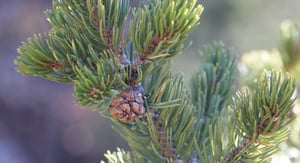
While there is still time to enjoy the last days of summer, soon days will become shorter and a new season will be upon us. Fall’s cooler temperatures make the perfect time to explore Western Colorado’s high deserts. Pine nuts from the Piñon Pine tree are a delicious wild food that will soon be ready for harvesting throughout the Piñon-Juniper forests.
Pine nuts were a staple for Colorado’s indigenous peoples long before Europeans colonized the west, and were traditionally used for food and medicine. We owe gratitude to Utes, Pueblo, Navajo, Shoshone, Cahuilla and Paiute for the knowledge of how to harvest pine nuts, and it is important to acknowledge the historic inhabitants of these lands by respectfully and sustainably harvesting pine nuts.
From August through early October, pine cones can be found on the branches of Piñon Pine Trees. Piñon Pines can be identified by the distinct curvature of their trunks and 1 to 2 inch long yellow-green needles which grow in packets of two. Not every tree will produce pine cones every year. Many environmental factors influence when trees will bear cones, but once you find a tree adorned with cones, be sure to put on a pair of gloves before gathering, otherwise your hands will be covered in Piñon sap! Pine cones will be light green to dark brown, depending on the stage of the cone, but it is best to harvest the cones while they are still green, as this will allow you to get to the nuts before birds and small mammals. Gather the green cones to take home with you. Lay the fresh cones out on a tray in a dry place and wait about 3 weeks or until the cones start to turn brown and split open, then you will be able to pick the nuts out.
To differentiate between pine nuts that are good to eat and ones that aren’t, pour all of the nuts into a container of water. The nuts that float to the top are likely not worth eating or do not actually have nuts inside, but the nuts that sink to the bottom are for keeping. Additionally, darker nuts are typically tastier and more nutrient-rich than the lighter colored ones. When you’ve found the nuts that are worth keeping, they must be shelled before eating. Though a tedious process, the reward is well worth it. Some people recommend using a rolling pin to split open the shells without breaking the pine nut inside. Not as hardy as they seem, pine nuts will need to be stored in the refrigerator or the freezer after being shelled if they are not going to be eaten within a few days, as they are actually quite perishable.
Pine nuts are high in fat and protein and can be enjoyed in a number of ways. Try pine nuts raw or roasted, add them to salads and meat dishes, or simply enjoy them as a nutritious snack. Many creative recipes can be found online, and some dishes include homemade pesto and pine-nut ice cream. Harvesting your own pine nuts can also save a great deal of money when compared to purchasing pine nuts from a store, which are usually imported from across the seas and marked at a high price. Remember to always forage sustainably, travel lightly, and only take as much as you need. Happy harvesting!
Note: Pinyon nuts can be collected on public lands managed by the BLM or USFS without a permit, as long as the amount being harvested does not exceed 25 pounds. Amounts which exceed 25 pounds are considered commercial and usage, and a permit is required.
Cassy Brown is the youth programs, and summer science camps, coordinator at Walking Mountains Science Center.








